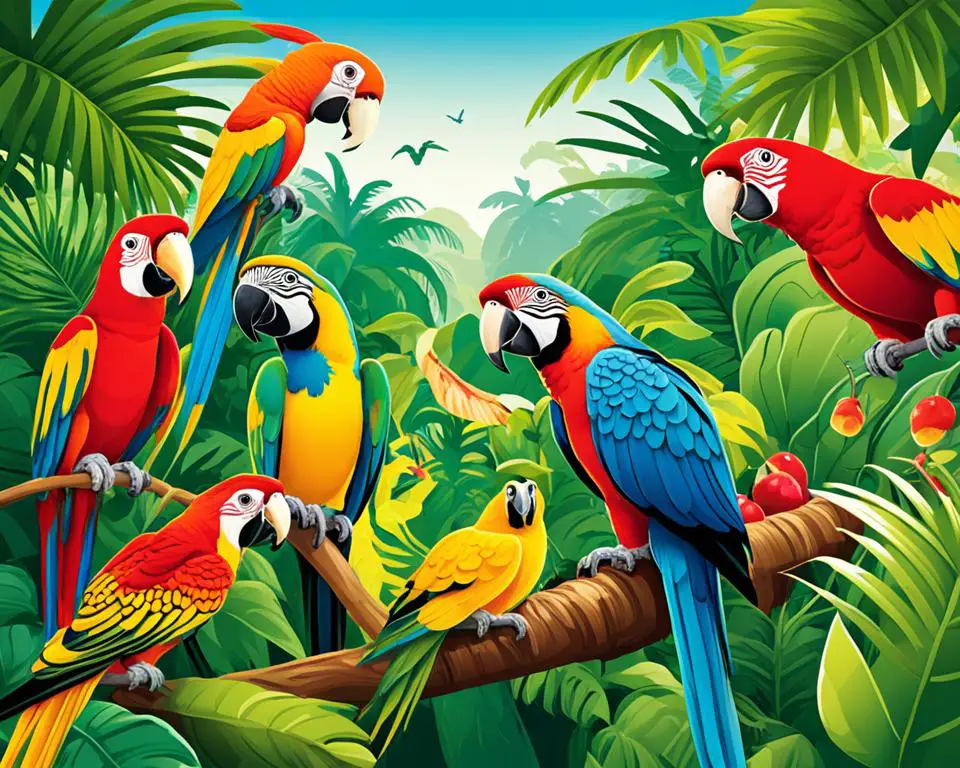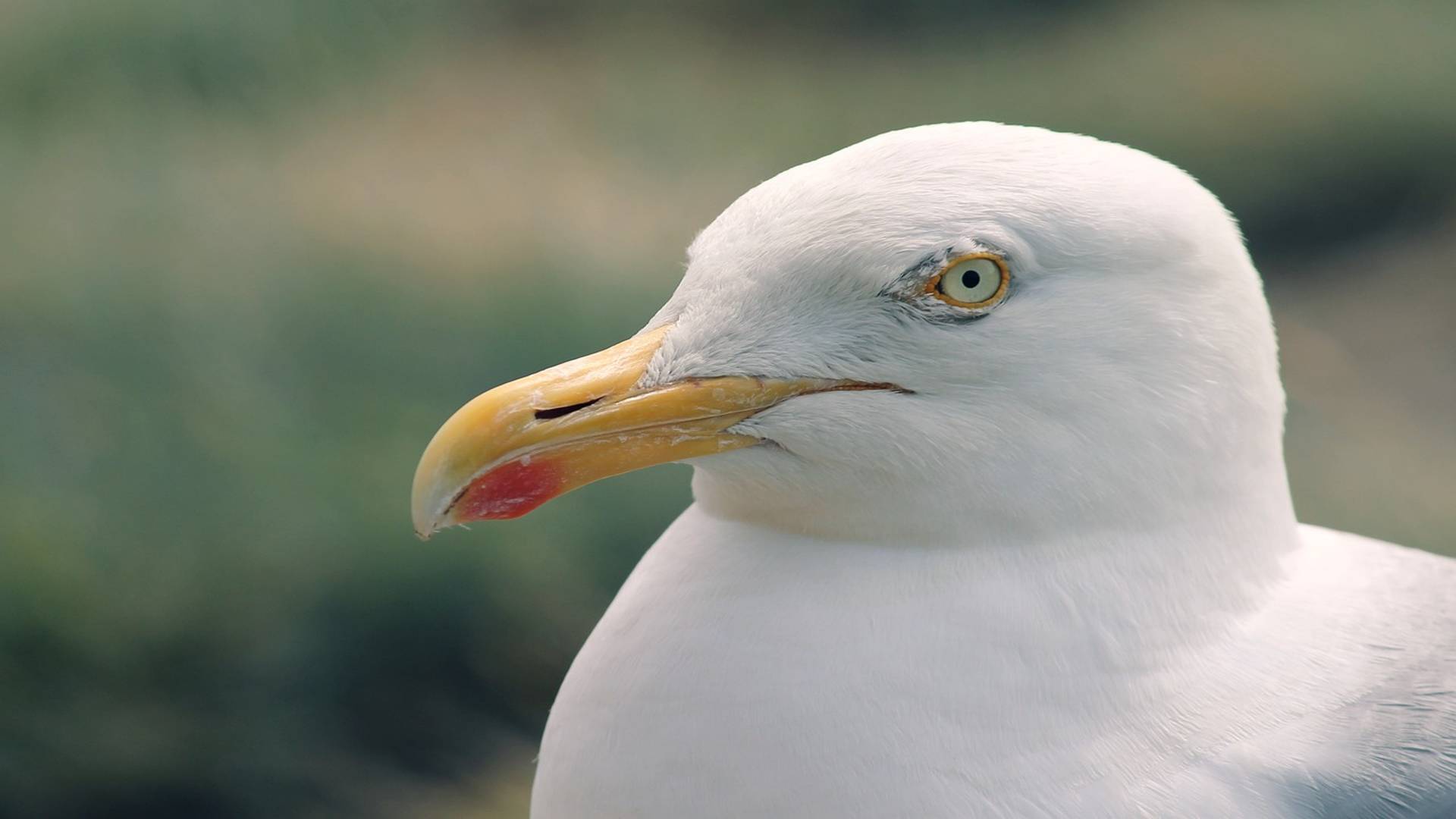Are you considering adding a Green Cheek Turquoise Conure to your family? These charming birds are known for their playful personalities and beautiful plumage.
However, as with any pet, caring for a Green Cheek Turquoise Conure requires time, effort, and knowledge. That’s why we’ve put together the ultimate guide to help you provide the best care for your feathered friend.
From diet and exercise to socialization and grooming, we’ve got you covered. So, let’s dive in and learn everything you need to know about caring for a Green Cheek Turquoise Conure!
Green cheek turquoise conure care: An Overview
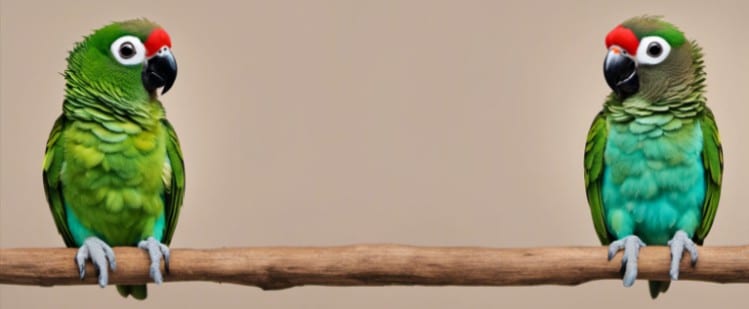
We are excited to introduce you to the Green Cheek Turquoise Conure, a medium-sized parrot that has become increasingly popular among bird enthusiasts. This beautiful bird is a subspecies of the green-cheeked conure, and is also known as the turquoise green cheek conure.
The Green Cheek Turquoise Conure is a stunning bird with a vibrant green body and turquoise blue feathers on its wings and tail.
It has a playful and curious personality, making it a great pet for those who are looking for an entertaining and interactive companion.
This species is native to South America, particularly in the Amazon Basin. They are social birds and are often found in flocks in the wild.
In captivity, they require plenty of social interaction and mental stimulation to thrive.
One of the most appealing aspects of the Green Cheek Turquoise Conure is its relatively small size, making it a great choice for those who want a pet bird but don’t have a lot of space. They typically grow to be around 10 inches in length and weigh between 60-80 grams.
Read also: Conure Growth Guide: When Do They Stop Growing?
Physical characteristics
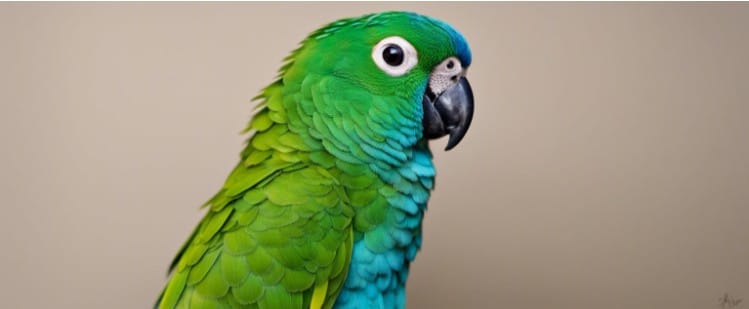
Size and colors
The Green Cheek Turquoise Conure is a small and colorful bird, measuring around 10 inches in length. They are primarily known for their vibrant greens, blues, and yellows, with black beaks and colorful markings on their plumage.
The turquoise green coloration is a particularly popular variation of the Green Cheek Conure, with its bright and striking appearance. Other popular mutations include the Pineapple and Cinnamon Green Cheek Conure, each with their own unique color patterns.
Read also: Why Do Conures Grind Their Beaks? 3 Possible Reasons
Types and mutations
The Green Cheek Turquoise Conure is just one of several types of Green Cheek Conures, each with its own distinct coloration and markings.
In addition to the Turquoise variation, there are also Pineapple Green Cheek Conures, Suncheeks, and yellow-sided green Cheek Conures.
Mutations are also common among Green Cheek Conures, with breeders often producing new and unique color patterns.
These mutations can include changes to the bird’s plumage, beak color, and other physical characteristics.
Origin and natural habitat
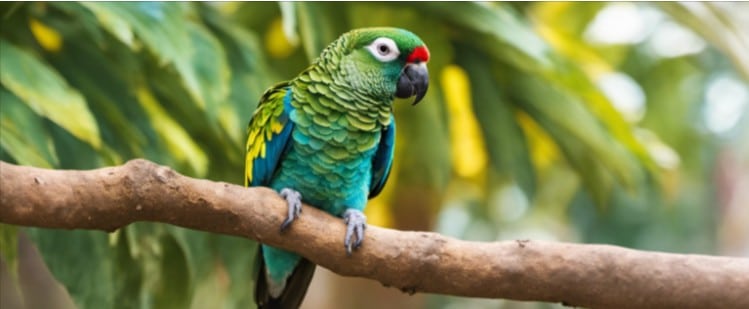
Geographical distribution
The Green Cheek Turquoise Conure, or Pyrrhura molinae, is a small parrot species that is native to Central and South America. Its natural range extends from southern Brazil to Bolivia, Paraguay, Argentina, and Uruguay.
It can also be found in other countries such as Belize, Colombia, Ecuador, Guyana, Peru, Suriname, and Venezuela.
In North America, the Green Cheek Turquoise Conure is a popular pet bird and can be found in many households. They are also present in the wild in some areas of Florida and Hawaii, where they were introduced by humans.
Habitat description
In the wild, Green Cheek Turquoise Conures inhabit a variety of habitats, including woodland, forest edges, and areas with thick vegetation. They prefer tall trees and are often found in the canopy layer of the rainforest. They are also known to live in agricultural areas, such as plantations and farms.
Green Cheek Turquoise Conures are social birds and are often found in flocks. They feed on a variety of fruits, seeds, and nuts, and are known to be excellent climbers. In the wild, they roost in tree cavities or nest in thick vegetation.
Behavior and temperament
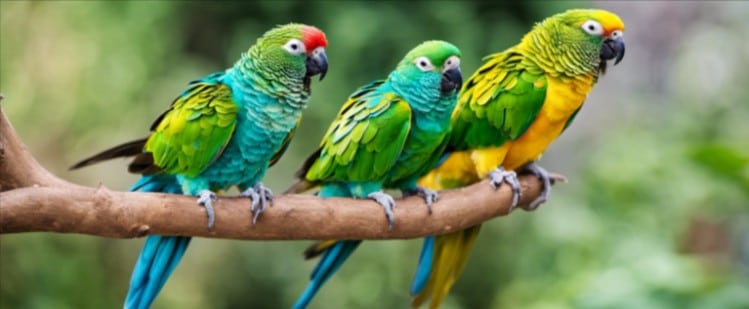
Personality traits
Green cheek turquoise conures are known for their playful, energetic, and curious personalities.
They are highly social birds and enjoy interacting with their owners and other birds. They are also known for their mischievous nature and love to explore their surroundings.
These birds are intelligent and can be trained to do various tricks, such as waving their wings or playing dead. However, they can also be stubborn at times and may require patience and consistency during training.
Green cheek turquoise conures are generally affectionate towards their owners and enjoy cuddling and being petted. They are not typically shy, but may take some time to warm up to new people and environments.
Speech and interaction
While green cheek turquoise conures are not known for their ability to mimic human speech patterns as well as some other parrot species, they can still learn a few words and phrases with proper training.
They are more likely to communicate through various vocalizations, such as chirping, squawking, and whistling.
These birds thrive on social interaction and require plenty of attention from their owners. They may become noisy or destructive if they do not receive enough mental and physical stimulation.
It is important to provide them with plenty of toys, perches, and other forms of enrichment to keep them happy and healthy.
Diet and nutrition
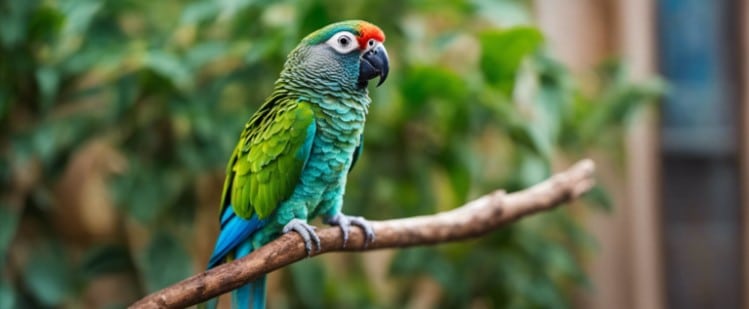
When it comes to feeding your green cheek turquoise conure, it’s important to provide a well-balanced diet that meets all of their nutritional needs. A healthy diet will help keep your bird in good health and prevent any deficiencies or health problems.
In the wild, green cheek turquoise conures primarily feed on fruits, vegetables, and seeds. As such, we recommend feeding your bird a diet that consists of a mix of fresh fruits and vegetables, as well as a high-quality seed mix.
Some of the best fruits to feed your bird include apples, bananas, grapes, and berries. These fruits are rich in vitamins and minerals that are essential for your bird’s health.
Vegetables like carrots, broccoli, and leafy greens are also great options, as they provide important nutrients like vitamin A and calcium.
When choosing a seed mix for your bird, it’s important to look for one that is high in quality and contains a variety of different seeds. Some good options include sunflower seeds, safflower seeds, and millet.
However, it’s important to keep in mind that seeds should only make up a portion of your bird’s diet, as they can be high in fat and lack important nutrients.
In addition to fruits, vegetables, and seeds, you may also want to offer your bird other types of food, such as pellets or cooked grains. These can be a good source of additional nutrients and can help provide variety in your bird’s diet.
Care and housing
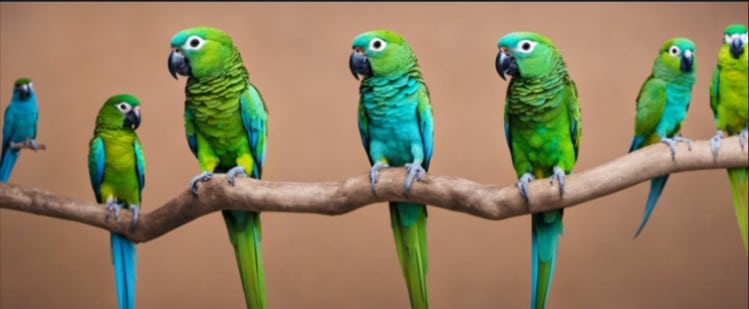
Cage requirements
When it comes to housing a Green Cheek Turquoise Conure, it is important to ensure that they have a cage that is appropriate for their size and activity level.
A minimum cage size of 24 x 24 x 24 inches is recommended for one bird, with larger cages being necessary for multiple birds.
The cage should be made of sturdy materials, such as stainless steel or powder-coated metal, and should have horizontal bars for climbing and exercise.
It is also important to provide a variety of perches and toys to keep your bird mentally and physically stimulated.
Natural wood perches of varying diameters can help prevent foot problems, while toys made of safe materials, such as untreated wood, leather, and rope, can provide entertainment and prevent boredom.
Feather Care
Feather picking can be a common problem in pet birds, including Green Cheek Turquoise Conures. To prevent feather picking, it is important to provide a healthy diet and plenty of opportunities for exercise and mental stimulation.
A balanced diet should include a variety of fresh fruits and vegetables, high-quality pellets, and occasional treats.
Regular baths or misting with a spray bottle can help keep your bird’s feathers clean and healthy. It is also important to regularly trim your bird’s nails and beak to prevent overgrowth and injury.
In addition to a healthy diet and grooming, it is important to provide a stress-free environment for your bird.
This can be achieved by minimizing loud noises and sudden movements, providing plenty of social interaction, and ensuring that your bird has a comfortable and secure place to sleep at night.
Adoption and cost
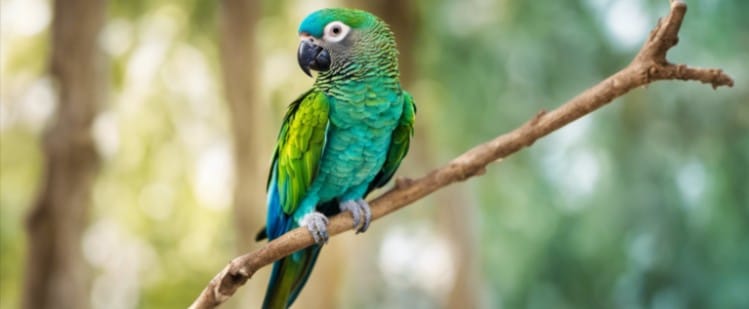
When considering adopting a Green Cheek Turquoise Conure, it’s important to keep in mind the cost associated with owning one of these birds.
While prices may vary depending on where you live and where you adopt from, you can expect to pay anywhere from $300 to $800 for a captive-bred conure.
It’s important to note that adopting a wild-caught conure is illegal and unethical. Always make sure to adopt from a reputable breeder or pet store that sources their birds ethically.
When adopting from a pet store, be sure to do your research and find a store that has a good reputation for caring for their animals. Some pet stores may have a bad reputation for keeping their birds in poor conditions, so it’s important to be cautious when adopting from a store.
If you choose to adopt from a breeder, make sure to ask about their breeding practices and if their birds are captive-bred. Captive-bred birds are generally healthier and more socialized than wild-caught birds.
Breeding information
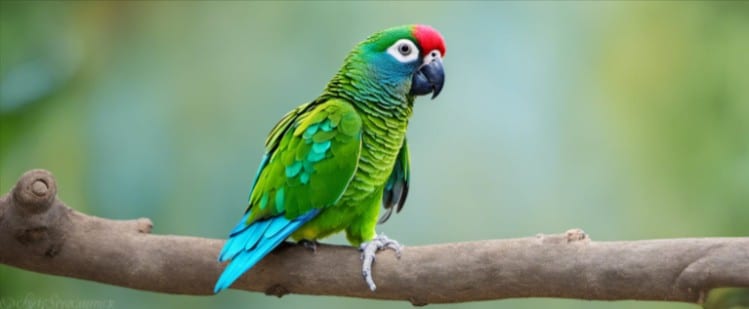
Breeding Green Cheek Turquoise Conures can be a rewarding experience for bird enthusiasts. These birds are monogamous and will mate for life, so it is important to choose a compatible pair for breeding. The breeding season for these birds begins in early spring and lasts until late summer.
It is important to provide a suitable nesting box for the breeding pair. The box should be large enough for the birds to comfortably move around in and should be placed in a quiet and secluded area of the aviary.
The nesting material should be soft and made of natural fibers such as coconut fibers or shredded paper.
Green Cheek Turquoise Conures are excellent parents and will take turns incubating the eggs and feeding the chicks.
The incubation period for these birds is approximately 23 days, and the chicks will fledge at around 6-8 weeks of age.
When breeding Green Cheek Turquoise Conures, it is important to monitor the health of the birds and provide them with a balanced diet.
A diet consisting of fresh fruits, vegetables, and high-quality pellets is recommended.
Read also: Green Cheek Conure Male Vs. Female Behavior (Explained [year])
It is also important to note that breeding these birds can be challenging and requires a certain level of experience and knowledge.
It is recommended to consult with a veterinarian or experienced breeder before attempting to breed Green Cheek Turquoise Conures.
Frequently Asked Questions
What is a conure bird?
A conure bird is a small to medium-sized parrot that belongs to the Aratinga genus. They are known for their playful and curious personalities, as well as their ability to mimic sounds and words.
Conures come in a variety of colors and patterns, and are popular pets due to their social nature.
What is the lifespan of a cinnamon turquoise green cheek conure?
The lifespan of a cinnamon turquoise green cheek conure is typically around 10 to 15 years in captivity. However, with proper care and attention, they can live up to 20 years or more.
What is the turquoise green cheek conure mutation?
The turquoise green cheek conure mutation is a genetic variation that results in a bird with a bright blue-green body and a yellow face. This mutation is relatively common in green cheek conures and is highly sought after by breeders and bird enthusiasts.
What is the rarest green cheek conure?
The rarest green cheek conure is the pineapple mutation, which features a bright yellow body and a red face. This mutation is highly prized by breeders and can be difficult to find.
How much is a turquoise green cheek conure?
The cost of a turquoise green cheek conure can vary depending on a variety of factors, including the bird’s age, gender, and mutation status. On average, you can expect to pay anywhere from $300 to $800 for a healthy, well-socialized bird.
How to take care of a turquoise green cheek conure?
To take care of a turquoise green cheek conure, you will need to provide them with a spacious cage, a balanced diet of fresh fruits and vegetables, and plenty of socialization and mental stimulation. You should also ensure that their environment is kept clean and free of hazards, and that they receive regular veterinary check-ups to maintain their health and well-being.
Summary
Before we move on to the conclusion, we’ve summarized this article into a short list of key points for you to remember:
- Green Cheek Turquoise Conures are medium-sized parrots known for their playful personalities and beautiful plumage.
- They require time, effort, and knowledge to care for properly.
- They are social birds that require plenty of interaction and mental stimulation to thrive.
- A well-balanced diet consisting of fresh fruits, vegetables, and high-quality seed mix is essential for their health.
- They require a spacious cage with perches and toys for exercise and entertainment.
- Proper grooming and a stress-free environment are also important for their well-being.
Final thoughts
That’s it!
Green Cheek Turquoise Conure is a beautiful and playful bird that makes a great pet for those willing to put in the time and effort to care for them properly.
We hope this reading has given you some insights about this amazing bird, and as always if you have anything you’d like to bring up, please leave feedback below, have a great day!
Want to learn more about Conures?
Ready to boost your knowledge to the next level? If so, check out the articles below:



